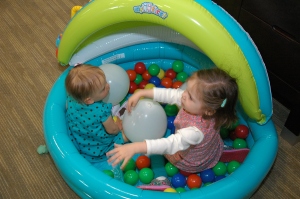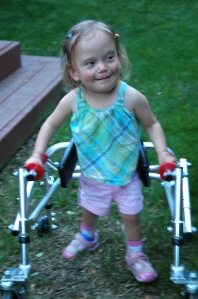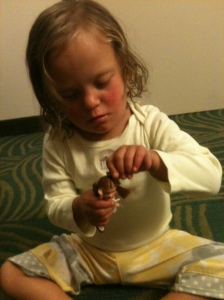I recently came across this article, which explains how therapists teach young children how to play and what the benefits of that training can be. Before the Bean came along, it never dawned on me that kids would need to be taught how to play. It just seemed to come naturally for any child I had ever known. But for the Bean, playing with toys was not a skill that came naturally. She loved to look at faces and interact socially, but had no idea what to do with the brightly coloured plastic and wooden objects we placed in front of her. She just ignored them completely.
In the article, Penina Ryback defines play as, “the way children practice and internalize both the rules and roles they see around them. Play helps children make sense of how their world works.” If a child is developmentally delayed or has a condition such as autism that makes it difficult for them to notice the rules and roles they are supposed to be practicing, they need some prodding to play like other kids play.
I notice this when we play with typical kids. When presented with a new toy or concept, they explore it using what they know, and then quickly branch out into other ideas as they observe others also interacting with the same thing. But for the Bean, it’s not as smooth or effortless a process.

The Bean is more interested in sucking on her fingers than all the new toys at her birthday party, but her friends are happy to take over.
When other kids the Bean’s age were engaging in parallel play (age one or so), she was still just learning how to sit, so she couldn’t interact with the toys like other kids did. It didn’t even seem like she was watching them play – she was engaged with me and any other adults who would interact with her and make eye contact. During this time, we were getting services from Easter Seals. The wonderful woman who came to our home for an hour each week was teaching the Bean how to interact with toys, and measuring her progress based on whether she could actually grasp a toy and pick it up, or switch a toy from hand to hand.

For her 2nd birthday, I made sure the activities were at her level, and luckily her typical friends thought it was fun too.
A year later, she was finally engaging with the toys that her friends were playing with a year previous, but they had moved on to more sophisticated activities. So once again, she was sitting with the adults playing with the toys while the other kids were starting to actually play with each other. Our Easter Seals therapy was focused on teaching the Bean how to stack blocks, turn the pages of board books, squeeze play doh, and matching wooden puzzle pieces to the right space on the board. She had some success, and was evaluated at about 6 months behind her peers.

At 3 years old, she was able to get around on her own with a walker. She was thrilled to be able to move around on her feet, but she still couldn’t keep up with her friends.
When she turned three we were still working on stacking, nesting, colouring and wood puzzles, and had also added some imaginitive play, recognizing and matching colours, shapes, and knowing the difference between big and little. The Bean was finally stacking one block on top of another, recognizing colours with some consistency, and could scribble a little with a crayon, but her speech capabilities were way behind, and her ability to focus on a task for very long was minimal. Many 3 year olds are happily reciting the alphabet, counting to 10, drawing/colouring with some precision,can write their name, and are totally ready for preschool. The Bean was being prepared for preschool as well, but it was clear that she was far from ready for integration into a regular preschool, so we enrolled her at Marindale, our County’s special needs preschool. It was the best thing that had ever happened to our Bean.
Without the play therapy we received from Easter Seals, I wouldn’t have had a clue what to expect from the Bean or how to encourage the development of these skills that, in my experience, usually came naturally. During her two years at preschool so far, she has made huge strides: now stacking large lego blocks into towers, drawing with more variety, playing with her imagination, constructing parts of more complicated puzzles, and imitating others with abandon. She has gotten to the point where she wants to be able to do what other kids are doing, which shows that she’s paying attention and learning a lot from those kids. Her speech is still very far behind other kids her age, but that is progressing as well.
We are nearing the time when we have to decide what Kindergarten will look like for our Bean. We are trying to be realistic and choose the options that will ensure her continued development success without overwhelming her. Our team of teachers, therapists and administrators are so totally on the Bean’s side, that I have no doubt we’ll make the right decision together.
